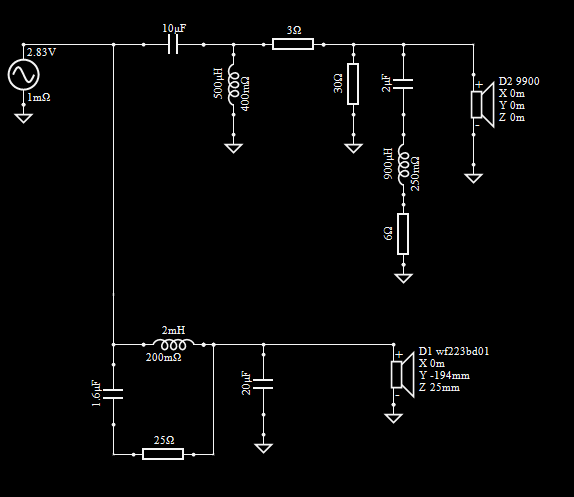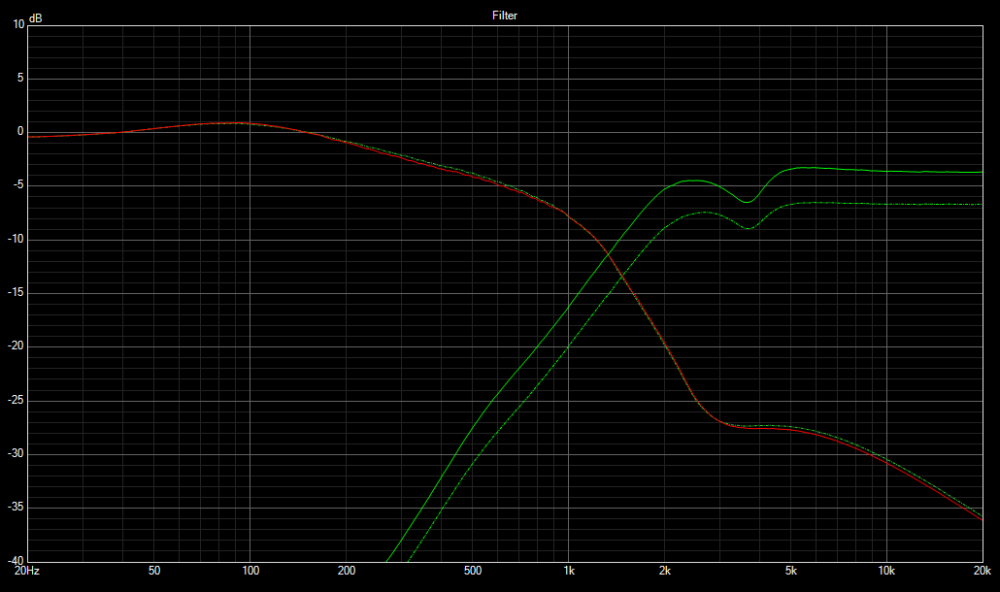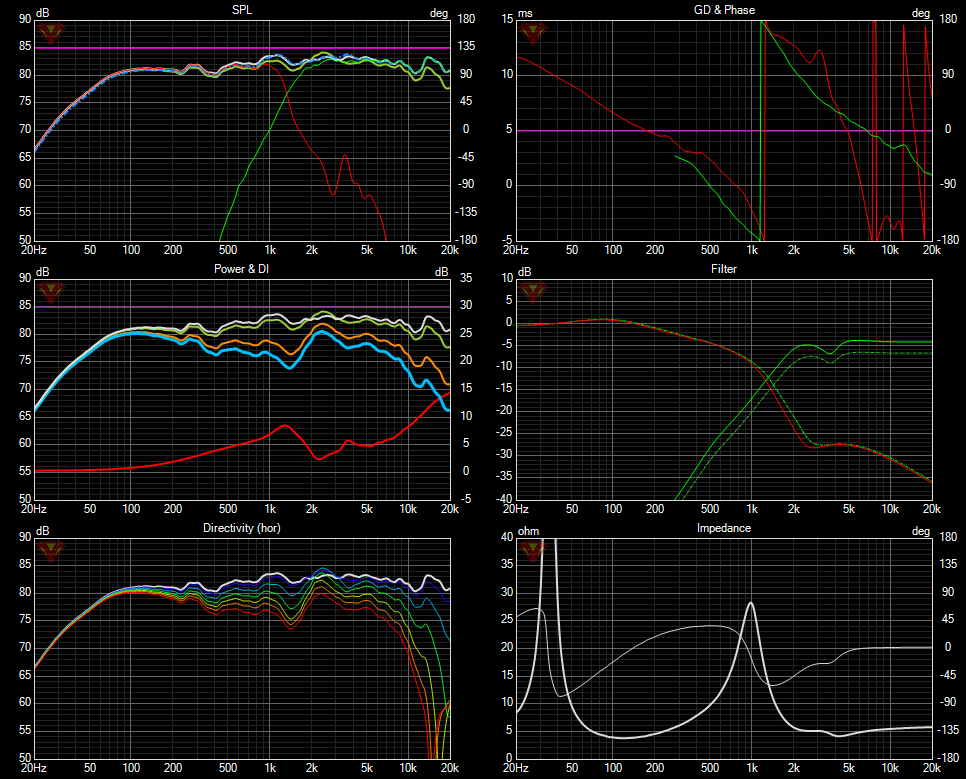If someone is open to destructive testing, Mylar has a melting point of 254 Celsius (489 Fahrenheit). Polypropylene properties are more variable, but the melting point is consistently lower. I would estimate around 170 Celsius (340 Fahrenheit). If you could extract a small piece of film and put it in the oven at 400 F, you would have your answer.
FWIW, I also recall those being advertised as poly. I never bought any because I still have a stock of the previous Madisound buyout GE poly 10 uF caps.
Keep an open mind, but don't let your brain fall out.
Quick update to this project. After listening to these for a while, I ended up dropping the tweeter level by adjusting the shunt resistor in the L-pad and I shortened the port to 9". The bass is now a little punchier and the treble now blends perfectly into the midrange, tightening up the soundstage in the process. These drivers are amazing and meet very nicely at the crossover point, though I wouldn't want to go too much further with either one. This speaker produces some of the cleanest transients I've ever heard and offers a remarkably full range at high output, especially for a stand mount design. Looking forward to showing these off at the next event!
And now that they're dialed in, they get a name... The Moon Songs
@DanP said:
Quick update to this project. After listening to these for a while, I ended up dropping the tweeter level by adjusting the shunt resistor in the L-pad and I shortened the port to 9". The bass is now a little punchier and the treble now blends perfectly into the midrange, tightening up the soundstage in the process. These drivers are amazing and meet very nicely at the crossover point, though I wouldn't want to go too much further with either one. This speaker produces some of the cleanest transients I've ever heard and offers a remarkably full range at high output, especially for a stand mount design. Looking forward to showing these off at the next event!
And now that they're dialed in, they get a name... The Moon Songs
@DanP said:
Quick update to this project. After listening to these for a while, I ended up dropping the tweeter level by adjusting the shunt resistor in the L-pad and I shortened the port to 9". The bass is now a little punchier and the treble now blends perfectly into the midrange, tightening up the soundstage in the process. These drivers are amazing and meet very nicely at the crossover point, though I wouldn't want to go too much further with either one. This speaker produces some of the cleanest transients I've ever heard and offers a remarkably full range at high output, especially for a stand mount design. Looking forward to showing these off at the next event!
And now that they're dialed in, they get a name... The Moon Songs
Would a WF223 DB01 (4 ohm ) used in this speaker be closer to matching tweeter output and a good choice? How would it sim with the 4 ohm woofer? Please excuse my novice question.
I made some guessing and attached it here for a preliminary network based on Dan's posted work.
The inductance is less on the 4 ohm, so more tilt will be required, so I increased the L1 to higher than half the initial value, as well as not halving the tweeter resistor for this reason. Nothing saying you couldn't give it a shot and adjust/tweak as necessary. Again- this is an educated guess, and no harm or ill-intent is meant, however, it may not be optimal.
Hopefully I'm not stepping on your toes, Dan. No offense intended towards you or your project either.
To answer the novice question, matching tweeter output is not necessary, nor does it provide any real benefit at all. Many PA systems are built with compression drivers that have a good 10dB greater sensitivity over the midbass. Tweeters are generally of higher sensitivity, a competent crossover network will take care of all "level matching" requirements.
Other than overall system impedance, a 4 ohm woofer variant will generally have T/S parameters that will work better in a smaller box than the 8 ohm equivalent. There's exceptions to every rule of course. As well, as Wolf is showing above, crossover network requires some redesign to change from 8 ohm to 4 ohm driver variant, they are not interchangeable.
Just playing around tonight. Here's My recommendation for a 4 ohm variant.
Dashed line is the Dan's design transfer function. Solid is my schematic above. Woofer transfer function matches with great accuracy, and the tweeter is not exactly the same, but roughly equivalent at the 3dB of boost needed.
Just getting back into things after a rough Thanksgiving break and a Covid Christmas. No toes stepped on at all and I'm not particularly happy with my xo as is on this project so I think what Wolf and Dcibel have done here are as good guesses as any.
If I were to step on toes, I’d suggest that Wolf is off by about 3dB.
I simply attempted to reproduce the filter transfer function as you've designed, no attempt at "improvement" or any change at all. In retrospect, equal transfer function on the woofer doesn't appear to provide exactly the same frequency response, but it is fairly close. If I were to reproduce the response as closely as possible with a 4 ohm woofer, it would look like this. With manufacturer graphs, the sound looks a bit "forward" but that doesn't mean much, real measurements may be quite different, especially the subtle waveguide of the tweeter isn't taken into account here.
It was a fun exercise to see the difference between simply swapping a 4 ohm variant of an 8 ohm driver into the equation.
Comments
If someone is open to destructive testing, Mylar has a melting point of 254 Celsius (489 Fahrenheit). Polypropylene properties are more variable, but the melting point is consistently lower. I would estimate around 170 Celsius (340 Fahrenheit). If you could extract a small piece of film and put it in the oven at 400 F, you would have your answer.
FWIW, I also recall those being advertised as poly. I never bought any because I still have a stock of the previous Madisound buyout GE poly 10 uF caps.
Sehlin Sound Solutions
Polyester = MKT = Dupont Mylar
Polypropylene = MKP
Polycarbonate = MKC
Polyethylene Terephthalate is another type of mylar.
There's also polystyrene, but they'd be huge if they were 'styrenes.
So- many 'poly' capacitor types.
InDIYana Event Website
I still have a pile of those, but I to thought they were poly.
I think you can dats and look for a roll off above 10,000 Hz
Quick update to this project. After listening to these for a while, I ended up dropping the tweeter level by adjusting the shunt resistor in the L-pad and I shortened the port to 9". The bass is now a little punchier and the treble now blends perfectly into the midrange, tightening up the soundstage in the process. These drivers are amazing and meet very nicely at the crossover point, though I wouldn't want to go too much further with either one. This speaker produces some of the cleanest transients I've ever heard and offers a remarkably full range at high output, especially for a stand mount design. Looking forward to showing these off at the next event!
And now that they're dialed in, they get a name... The Moon Songs
What were the box volume and final port dimensions?
0.75 cu ft net box volume
2" dia x 9" long port
11 parts, are you crazy?
Seriously, they look good, can't wait to hear them.
Is this the tweeter?
ScanSpeak Revelator D2905/9900-00 1" Tweeter Textile Dome
https://www.madisoundspeakerstore.com/scanspeak-soft-dome-tweeters/scanspeak-revelator-d2905/9900-00-1-tweeter-textile-dome/
Yessir it is. This tweeter design is over 30 years old at this point (I believe) and is still one of the best tweeters money can buy.
A bit pricey though.
You get what you pay for
https://hificompass.com/en/speakers/measurements/scan-speak/scanspeak-d2905990000
Should have taken the opportunity to get a pair at a deal that I linked in your tweeter thread over here:
https://diy.midwestaudio.club/discussion/1557/best-tweeter/p1
(first reply)
Would a WF223 DB01 (4 ohm ) used in this speaker be closer to matching tweeter output and a good choice? How would it sim with the 4 ohm woofer? Please excuse my novice question.
I made some guessing and attached it here for a preliminary network based on Dan's posted work.
The inductance is less on the 4 ohm, so more tilt will be required, so I increased the L1 to higher than half the initial value, as well as not halving the tweeter resistor for this reason. Nothing saying you couldn't give it a shot and adjust/tweak as necessary. Again- this is an educated guess, and no harm or ill-intent is meant, however, it may not be optimal.
Hopefully I'm not stepping on your toes, Dan. No offense intended towards you or your project either.
InDIYana Event Website
To answer the novice question, matching tweeter output is not necessary, nor does it provide any real benefit at all. Many PA systems are built with compression drivers that have a good 10dB greater sensitivity over the midbass. Tweeters are generally of higher sensitivity, a competent crossover network will take care of all "level matching" requirements.
Other than overall system impedance, a 4 ohm woofer variant will generally have T/S parameters that will work better in a smaller box than the 8 ohm equivalent. There's exceptions to every rule of course. As well, as Wolf is showing above, crossover network requires some redesign to change from 8 ohm to 4 ohm driver variant, they are not interchangeable.
Just playing around tonight. Here's My recommendation for a 4 ohm variant.

Dashed line is the Dan's design transfer function. Solid is my schematic above. Woofer transfer function matches with great accuracy, and the tweeter is not exactly the same, but roughly equivalent at the 3dB of boost needed.

Just getting back into things after a rough Thanksgiving break and a Covid Christmas. No toes stepped on at all and I'm not particularly happy with my xo as is on this project so I think what Wolf and Dcibel have done here are as good guesses as any.
If I were to step on toes, I’d suggest that Wolf is off by about 3dB.
I simply attempted to reproduce the filter transfer function as you've designed, no attempt at "improvement" or any change at all. In retrospect, equal transfer function on the woofer doesn't appear to provide exactly the same frequency response, but it is fairly close. If I were to reproduce the response as closely as possible with a 4 ohm woofer, it would look like this. With manufacturer graphs, the sound looks a bit "forward" but that doesn't mean much, real measurements may be quite different, especially the subtle waveguide of the tweeter isn't taken into account here.
It was a fun exercise to see the difference between simply swapping a 4 ohm variant of an 8 ohm driver into the equation.


Hello Dan,
It looks like you experienced the same dip in the woofer as here,
https://pkaudio.webnode.cz/nextwavess/